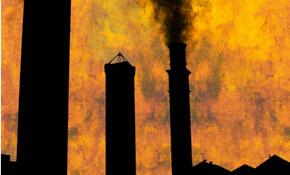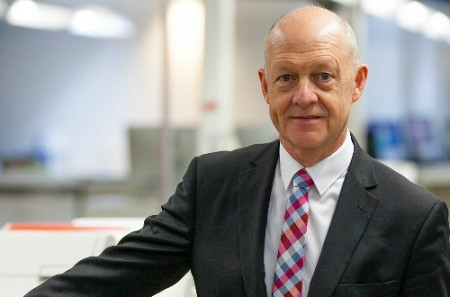
A n emission trading scheme (ETS) is yet to materialise, despite all the column inches and cross-party political insult-flinging. Following lots of bluff and bluster, the winds of change did not sweep through December’s much-hyped Copenhagen climate talks. But it’s clear businesses had better prepare themselves to cut emissions. Don’t believe in climate change? Too bad – it’s likely that legislation to deal with it will still affect you.
Legislation is inevitable, says Rodney Wade, national environmental and technical manager at Finsbury’s Green. “Regardless of what form the Carbon Reduction Pollution Scheme [CPRS] takes – or even whether a cap and trade scheme is workable – legislation in Australia to reduce carbons emissions is inevitable.
“Sadly, it will require government to legislate in order to get some consistent and co-ordinated action,” adds Wade. “Industry and private individuals are not likely to impact the reduction in green-house gases enough without this type of push.”
David Fuller, director of Focus Press, which last year received a NSW Government award for its long-held sustainability practices, says: “If there is to be a tax as such, it needs to be backed up by legislation. The government also needs to be involved at international level to try and maintain a level playing field when it comes to trade.”
An ETS is a market-based mechanism aimed at controlling emission volumes. Hagop Tchamkertenian, national manager for policy and government affairs with Printing Industries Association of Australia, says the scheme is an efficient way of controlling emissions because it determines an annual emissions target. “It is superior to carbon taxes – which is an environmental tax on carbon dioxide.”
Geoff Lawyer, a director of FSC-certified Complete Colour Printing, is not so sure about the existing ETS proposition. “As it stands, the current white paper needs to be more specific on what is the end goal and how it is going to be achieved, not just focusing on how it is going to be charged to the wider – read ‘business’ – community.
Fuller’s view is that because the ETS is a method of putting a tax on fuel, it’s “possibly not a bad thing” – if it makes cleaner fuels will become more viable.
Tchamkertenian says there are still question marks over what is the best solution to control emissions. “About 18 months ago, the ETS was considered by most as the superior solution.
However the dynamics have changed due to the Opposition rejection of the ETS and the disappointing Copenhagen conference.
“If the government is determined to enforce it on industry, then it needs to clearly demonstrate that [an ETS] is still is a superior scheme.”
Industry division
A Printing Industries’ climate change online survey in October showed 20.5% of respondents preferred carbon taxes, while 18.2% supported the proposed ETS. However, 36.4% preferred neither, while 22.7% indicated they needed more information to make a decision.
So will an ETS hurt printers? Far from it, says Fuller. His firm’s green improvements have cut $63,000 off the electricity bill in one year, while reducing carbon emissions by a third. Focus measures every single input that goes into printing, giving it a carbon value for everything they print. “Most of us will come up with initiatives that will reduce energy use,” he reckons. But not everyone shares Fuller’s positivity.
In the Printing Industries climate change survey, 30.2% said they would be forced to downsize. Tchamkertenian adds: “Whatever scheme is ultimately introduced will impact on the printing industry.”
Of the four channels of impact under the current proposals – energy costs, raw material costs, consumable costs (mainly paper) and transportation – all would increase under a CPRS, he says.
“Unless the printing industry is adequately compensated for these expected cost increases, the proposed ETS will impact negatively on the printing industry.”
Is it worth taking action now? “You will have a better business if you do,” says Fuller.
Tchamkertenian reckons that taking early action will help printers become energy efficient and minimises their environmental footprint. He adds that it’s worthwhile taking action now because those actions will have a positive effect on the bottom line.
Complete Colour’s Lawyer says his company has been taking action for more than seven years to become more environmentally responsible. Initiatives include reducing power consumption and diverting waste by more than 92% – “while still increasing turnover”.
While some printers find that ‘green printing’ makes business sense, there’s a feeling others are just paying lip service. Finsbury Green’s Wade says for some printers, action on climate change will be too little, too late.
Printers – and the Australian Conservation Foundation – say customers should beware of those who claim ISO 14001 as a mark of carbon reduction. The standard doesn’t measure carbon footprints. However, Fuller says achieving ISO 14001 gave Focus the framework to be able to measure its carbon impacts.
“ISO 14001 helped us in a number of ways. Regarding carbon, it has helped us through data collection and staff engagement to be involved in reviewing data regularly and see trends as well as tracking success or failure of initiatives to reduce impacts.”
Lawyer says Complete Colour had been looking at reducing its carbon footprint for many years before achieving the standard. “In fact, we considered ISO 14001 as a ratification of some of the environmental initiatives we had. There are many other initiatives that we introduced into our business that do not form part of the criteria of ISO 14001.
“Having it helps us achieve better participation from our staff in the new environmental initiatives we introduce whether they relate to carbon or not.”
Measure and manage
So how do you measure your carbon footprint? In the UK, the British Standards Institute has developed a carbon footprint standard PAS 2050. It allows a comparison of goods using a common, recognised and standardised approach to life cycle greenhouse gas emissions. So it removes the “apples and oranges” comparison, and puts everyone on the same playing field. UK print’s peak trade body, the British Printing Industries Federation, has used PAS 2050 to create its own carbon calculator for printers. There are a host of online carbon calculators (see box) to help you figure out your carbon footprint.
Business Victoria recommends you first restrict the calculation to your own business activities, such as energy use, travel and waste. However, it can also be important – though difficult – to calculate the impact of your suppliers’ emissions as well. Free online calculators may vary in their results – probably because each will ask for slightly different inputs. Don’t let this deter you: they’re a good place to start. If you’re really serious about reducing carbon, a consultant could be the way to go.
Tchamkertenian says Printing Industries’ Sustainable Green Print (SGP) programme is based on the ISO 14001 framework, with the additional benefit of outlining printing-industry specific environmental risks and supplying the control measures to manage those risks.
“This unique feature of the SGP presents printing companies with a greater potential to reduce their environmental footprint.”
Then there are several further steps you can take almost immediately. First, measure your carbon footprint. Talk to other businesses. What are they doing? What were their challenges? What
would they do differently? You could also check out Printing Industries’ Sustainable Green Print programme or GASAA’s Truly Green initiative.
Comment below to have your say on this story.
If you have a news story or tip-off, get in touch at editorial@sprinter.com.au.
Sign up to the Sprinter newsletter



